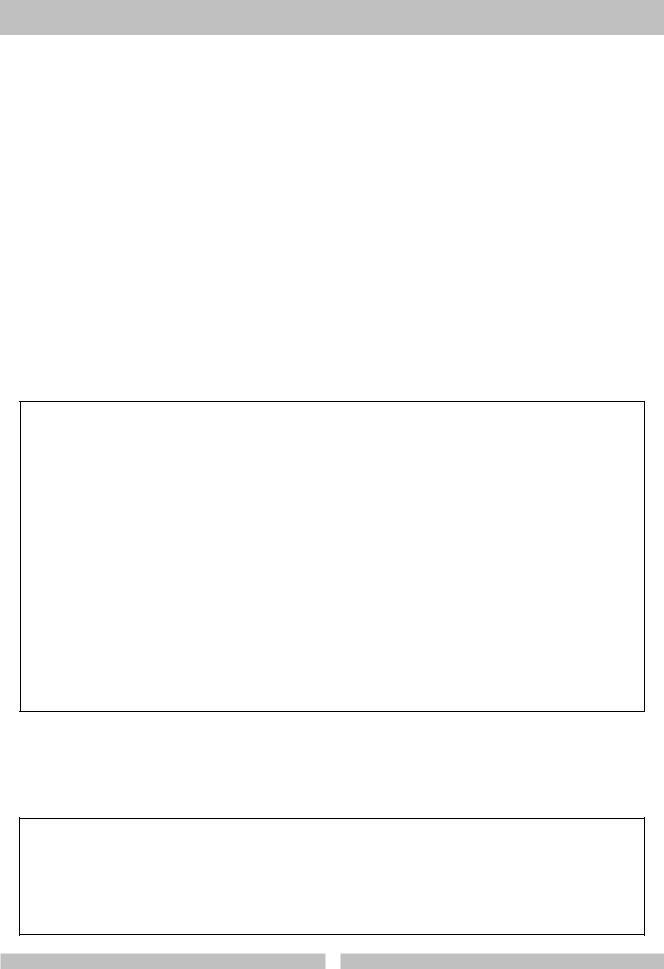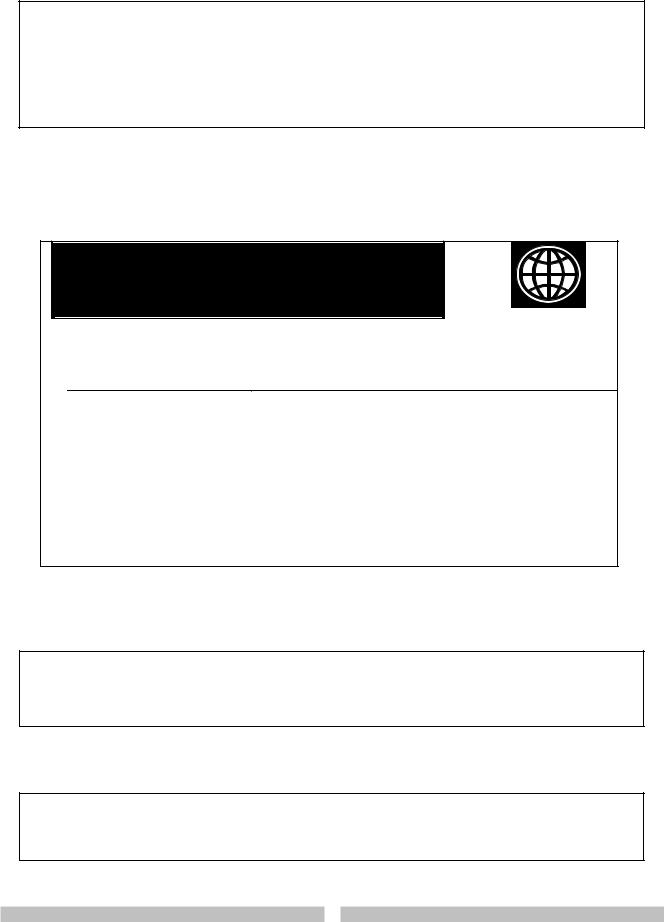
Translation_Style_Guide_WB
.pdf
THE WORLD BANK
TRANSLATION STYLE GUIDE
ENGLISH EDITION
© 2004 The International Bank for Reconstruction and Development / The World Bank Translation Services
1818 H Street, N.W. Washington, DC 20433
Version 1.0, printed June 2004
Printed in the United States of America
Readers are welcome to reproduce portions of this work. Please credit The World Bank, Translation Services. Suggestions for additions or
improvements to this guide are welcome (translation-vm@worldbank.org).

|
ENGLISH |
World Bank Translation Style Guide |
FRENCH |
Version 1.0 |
ARABIC |
|
SPANISH |
Table of Contents |
RUSSIAN |
Preface.................................................................................................................................................................... |
1 |
General Guidelines............................................................................................................................................... |
3 |
Introduction ...................................................................................................................................................... |
3 |
Spelling Rules ................................................................................................................................................... |
4 |
Sample/Standard World Bank Text.............................................................................................................. |
4 |
Capitalization........................................................................................................................................................ |
7 |
General Guidelines .......................................................................................................................................... |
7 |
Geographic Names .......................................................................................................................................... |
7 |
Institutional Names ......................................................................................................................................... |
8 |
Project Names................................................................................................................................................... |
9 |
Punctuation, Typing, Headings, Titles............................................................................................................ |
11 |
Punctuation and Typing ............................................................................................................................... |
11 |
Headings, Titles.............................................................................................................................................. |
13 |
Acronyms, Abbreviations, Compounds ......................................................................................................... |
15 |
Acronyms and Abbreviations ...................................................................................................................... |
15 |
Compound Words ......................................................................................................................................... |
17 |
Numbers, Measurements .................................................................................................................................. |
19 |
General Guidelines ........................................................................................................................................ |
19 |
Dates ................................................................................................................................................................ |
19 |
Time ................................................................................................................................................................. |
19 |
Ranges of Numbers, Dates, Pages ............................................................................................................... |
20 |
Ordinal Numbers........................................................................................................................................... |
20 |
Commas, Decimals ........................................................................................................................................ |
20 |
Units of Measurement................................................................................................................................... |
20 |
Currency.......................................................................................................................................................... |
21 |
Names .................................................................................................................................................................. |
23 |
Official Names of the World Bank Group.................................................................................................. |
23 |
World Regions, Country Names.................................................................................................................. |
23 |
Other Official Names..................................................................................................................................... |
24 |
Annexes ............................................................................................................................................................... |
25 |

|
World Bank Translation Style Guide |
|
|
ENGLISH |
|
|
|
FRENCH |
|
|
Version 1.0 |
|
|
ARABIC |
|
|
|
|
SPANISH |
|
Preface |
|
|
|
|
|
|
RUSSIAN |
As a preface to this Translation Style Guide, it is useful and appropriate to highlight the following quote from The World Bank Publications Style Guide, a comprehensive editorial manual on which the present guide draws much of its overall structure and English content:
For an international institution like the Bank, the best style is one that is simple, logical, and clear. The author should assume that not all readers will be native speakers of English and that many of them will be outside the Bank. Any translations are more likely to be accurate if the original text is well written.
As far back as May 1952, a similar message was conveyed in another style guide of sorts:
a 20-page transcript of a talk given to staff by a former World Bank Vice-President, Sir William Iliff, under the title “Gobbledygook”—defined by the speaker as “an unpleasing, polysyllabic, often meaningless jumble; a written language that sets itself up to pass for English.”
In his talk, Sir Iliff emphasized a dozen ways to counter gobbledygook at the World Bank. In a postscript later added to the transcript in response to feedback from one of his listeners, he expounded on the same intricate link between clear English and accurate translation. This is what he wrote:
Mr. Antony Balazy has pointed this out to me: my talk complained that Gobbledygook was often unintelligible to the English-speaking reader; but I did not mention that almost impossible task that faces a translator who is asked to translate Gobbledygook into French or German
or Spanish.
“Plain English,” he says, “makes the job of the translator easy.”
This is worth remembering, because much of our Bank literature, composed in English, has to be translated into other languages.
Yet, for all its importance and integral place in the communication process, translation
at the World Bank has never followed a comprehensive set of guidelines similar to those defined for editorial content. The present Translation Style Guide is meant to fill this gap.
Because it is geared not just to World Bank translators (both staff and contractors) but also
to anyone who handles translation in one way or another (language assistants, reviewers, requesters, project or task managers, etc.), this guide is more than a linguistic handbook. It actually consists
in a series of language-specific manuals that share a common structure and use English for their core content of guidelines and explanations, providing additional rules and concrete examples
in the respective languages as necessary.
Through this bilingual approach, the translation business unit of the World Bank, which developed the Translation Style Guide in collaboration with various partners and stakeholders, hopes to reach a wide-ranging, diversified audience, with one major objective in mind: to enhance consistency in the way this institution communicates in English and in other languages.
1

|
World Bank Translation Style Guide |
|
|
ENGLISH |
|
|
|
FRENCH |
|
|
Version 1.0 |
|
|
ARABIC |
|
|
|
|
SPANISH |
|
General Guidelines |
|
|
|
|
|
|
RUSSIAN |
Introduction
Style Issues in English Translation
A translation is not just a transcription from one language into another. It needs to render not only the meaning of words and sentences but also the context and, more subtly, what is sometimes described in stylistic manuals as the register of the source text—its level and style of language.
If the original text is simple and concrete, the translator can generally “stay close” to it. With speeches or official correspondence, however, style is more of the essence, so the translation, while striving to convey the correct meaning, must not be so close to the original as to read in an unnatural, awkward way.
Translation of World Bank Documents: Some Pointers
Most documents translated by the World Bank are technical in nature and thus require careful and thorough research. In addition to conceptual and factual accuracy, correct use of specialized terminology and attention to detail and nuance are considered to be the hallmarks of a sound translation.
In general, World Bank documents cover a fairly wide variety of such topics as finance, health, education, and poverty reduction. For translators who wish to familiarize themselves with typical Bank documents, a good starting point would be the Bank’s website (http://www.worldbank.org/).
On that site, they will find at a glance information about the World Bank, how it is organized and what it does, as well as links to Bank documents and reports or news and events. In particular, documents pertaining to the Annual and Spring Meetings of the World Bank Group and the International Monetary Fund will serve as a good source of reference for issues that are high on the Bank’s agenda.
Note: Document Formatting
As a general rule, and unless instructed otherwise, translators of World Bank documents are expected to respect and replicate the format of the source text. One simple way to do so is to overwrite the contents of the original file (making sure to rename it in order to identify the newly saved file as the translated version).
In addition to ensuring a consistent appearance between the original document and the translation, overwriting of the source text also helps to minimize such common translation errors as the accidental omission of parts of text (for example, a sentence in the middle of a paragraph). This is not to say that translators are not free to alter the flow of sentences within a paragraph if and as warranted by stylistic considerations—for instance, by combining two sentences into one (a common practice when translating from English especially). But even in such cases, the overall content and sequence of full paragraphs must be respected, again for the sake of consistency between original and translated documents.
3

General Guidelines
Spelling Rules
The official language of the World Bank is American English, and English spelling and punctuation should follow American usage— except in the case of proper names with British spelling (e.g., International Centre for Settlement of Investment Disputes, United Nations Development Programme).
Webster’s Tenth New Collegiate Dictionary is the Bank’s preferred authority for spelling;
if it gives more than one spelling, use the first.
|
ENGLISH |
|
|
Spelling differences: |
|
American |
British |
[no final e] annex |
[final e] annexe |
-ck check |
-que cheque |
-ense defense |
-ence defence |
-er adviser |
-or advisor |
-er center |
-re centre |
-g catalog |
-gue catalogue |
-i tire |
-y tyre |
-ixes appendixes |
-ices appendices |
-ize organize |
-ise organise |
-l traveler |
-ll traveller |
-m program |
-mme programme |
-or labor |
-our labour |
-ow plow |
-ough plough |
Sample/Standard World Bank Text
World Bank Mission Statement
This is the text of the official World Bank Mission Statement:
Mission Statement
Our dream is a world free of poverty
To fight poverty with passion and professionalism for lasting results.
To help people help themselves and their environment by providing resources, sharing knowledge, building capacity, and forging partnerships in the public and private sectors.
To be an excellent institution able to attract, excite, and nurture diverse and committed staff with exceptional skills who know how to listen and learn.
Our Principles
Client centered, working in partnership, accountable for quality results, dedicated to financial integrity and costeffectiveness, inspired and innovative.
Our Values
Personal honesty, integrity, commitment; working together in teams — with openness and trust; empowering others and respecting differences; encouraging risk-taking and responsibility; enjoying our work and our families.
Bank Publications
This is a sample of standard clauses on copyright pages of many publications such as the World Development Report:
All rights reserved. No part of this publication may be reproduced, stored in a retrieval system, or transmitted, in any form or by any means, electronic, mechanical, photocopying, recording, or otherwise, without the prior permission of the World Bank.
Manufactured in the United States of America First printing September 2001
4

General Guidelines |
ENGLISH |
|
|
This volume is a product of the staff of the World Bank, and the judgments made herein do not necessarily reflect the views of its Board of Executive Directors or the countries they represent. The World Bank does not guarantee the accuracy of the data included in this publication and accepts no responsibility whatsoever for any consequence of their use. The boundaries, colors, denominations, and other information shown on any map in this volume do not imply on the part of the World Bank any judgment on the legal status of any territory or the endorsement or acceptance of such boundaries.
Bank Press Releases
This is an example of the formatting and header content of a standard press release with embargo in English:
EMBARGOED: not for news wire transmission, posting on websites, or any other media use until September 16, 2003 at 10:00 a.m. EDT (Washington time) or 7:00 p.m. (Moscow time)
The World Bank
Contacts:
In Washington: Merrell Tuck-Primdahl (202) 473-9516
mtuckprimdahl@ worldbank.org
In Moscow: Marina Vasilieva (+7095) 745 7000 ext.2045
mvasilieva@ worldbank.org
TACKLE HIV/AIDS IN EASTERN EUROPE AND
CENTRAL ASIA NOW, URGES WORLD BANK
IN NEW REGIONAL STRATEGY
WASHINGTON, September 16, 2003—
Bank Documents
These are standard clauses on cover pages of official World Bank documents:
FOR OFFICIAL USE ONLY
This document has a restricted distribution and may be used by recipients only in the performance of their official duties. Its contents may not otherwise be disclosed without World Bank authorization.
In the context of the Disclosure Policy, World Bank documents carry the following disclaimer notice for translated versions:
This document is a translation of the document [TITLE], dated [DATE], which is provided as a service to interested parties. If any text of the original document in English is inconsistent with the text of this translation, the original document in English shall govern.
5

General Guidelines |
ENGLISH |
|
|
The contents of all project documents are standardized. Here are, for example, the standard section headings of an Implementation Completion Report:
A. |
Project Data |
F. |
Sustainability |
B. |
Principal Performance Ratings |
G. |
Bank and Borrower Performance |
C. Assessment of Development Objective and Design |
H. |
Lessons Learned |
|
|
and of Quality at Entry |
I. |
Partner Comments |
D. Achievement of Development Objective and Outputs |
J. |
Additional Information |
|
E. |
Major Factors Affecting Implementation and Outcome |
K. |
Annexes |
|
|
|
|
Letters, Correspondence
Following is an excerpt from a standard official letter to a member country, showing the letterhead, address block, formal greeting and signature:
The World Bank |
1818 H Street N.W. |
(202) 477-1234 |
INTERNATIONAL BANK FOR RECONSTRUCTION AND DEVELOPMENT |
Washington, D.C. 20433 |
Cable Address: INTBAFRAD |
INTERNATIONAL DEVELOPMENT ASSOCIATION |
U.S.A. |
Cable Address: INDEVAS |
|
|
April 16, 2003 |
His Excellency |
|
|
Mr. John Smith |
|
|
Minister of Finance and Economy |
|
|
Ministry of Finance and Economy |
|
|
Cotonou, Republic of Benin |
|
|
BENIN: Private Sector Development Project (Cr. 3333 BEN)
Second Amendment to the Development Credit Agreement
Excellency:
…
Sincerely,
Jane Doe
Country Director for Benin
Africa Region
6
